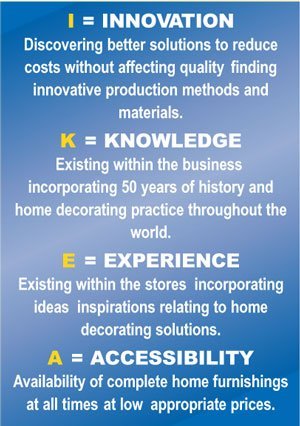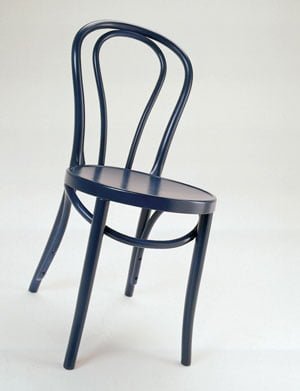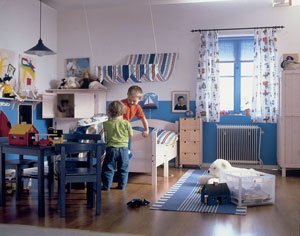“Once upon a time, a long, long time ago we decided that, instead of making furniture for people with fat wallets, we would side with the majority of people instead and offer them a better everyday life. We decided to offer a wide range of home furnishing items of good design and function, at prices so low the majority of people could afford to buy them.” Ingvar Kamprad.

Many successful businesses stem from one simple good idea. Someone with a bit more vision than average spots a gap in the market. He or she notices that existing producers are failing to provide the benefits that consumers are really looking for.
This case study focuses on a particularly successful business idea which resulted in the foundation of IKEA, one of the largest home furnishing companies in the world. It examines IKEA’s vision/mission statements and considers how consumer needs can be met. In many ways, IKEA was a forerunner in pioneering concepts which are becoming increasingly important in modern business. These include:
- ethical business practice
- providing a fair deal for and being led by consumer needs
- empowering employees, so that they feel a part of the company
- responsibility to the community in which the company operates and to the wider community.
IKEA started in Sweden over 50 years ago with one man’s vision. Ingvar Kamprad, the founder of IKEA, asked the questions:
- Why are nice homes only possible for people with a lot of money?
- Why shouldn’t everybody be able to afford a nice, functional home?
- Why does furniture have to be so expensive?
- Why is there no one offering a wide range of home furnishing articles of good form and function at prices so low that the many people can afford them?
Ingvar Kamprad wanted to help create a better everyday life for the people in the area of Sweden where he lived. He was brought up in a farming community where ordinary people were struggling to make a living out of stony fields and limited resources. Nothing could be taken for granted and survival meant hard work, ingenuity and working together. Ingvar Kamprad’s desire to help ordinary people founded the basis of a strong company culture which has helped to make IKEA so successful. It is not surprising that IKEA comes from Sweden – a country which has long been famous for the way in which it cares for its citizens. In a recent IKEA publication, Democratic Design, the concept of giving everyone the same opportunity in life is set out in the following way:
“..everyone who has grown up in Sweden has learnt – either from their Dad, or from society in general – people who are not all that well off should still be given the same opportunities as people who are. It’s hardly surprising that, as a Swedish company, IKEA espouses Swedish values.”
Business start-up
The IKEA concept was a revolutionary one which was well ahead of its time. Essentially, IKEA has built an anti-brand which stands for the good of the many people rather than a narrow group of shareholders. IKEA began with the question: ‘Who’s on the side of the customer?’ From this stemmed a corporate philosophy which asked two further questions:
- ‘Isn’t there room for an anti-brand that stands for low price, high quality and innovation?’
- ‘Isn’t there room for an anti-brand that stands for the benefit of everyone?’
High quality at affordable prices

In order to realise the aims of his business idea, Kamprad needed a way of designing which would make it possible to maintain high quality standards, while at the same time making reductions in price. The solution he came up with was based on common sense and a respect for the customer. He carried out detailed research in the different life stages and the needs of customers at each stage (e.g. setting up home for the first time, raising a young family, retiring etc.). From this, he was able to calculate what customers would be able to afford, while still having some money over. Then he sourced the right materials and the production units which had the expertise and capacity to produce goods economically. In many cases, he approached producers who were not part of mainstream furniture manufacturing. For example, a shirt manufacturer may well be suited to producing loose covers for settees and beds.
Large IKEA stores were built on the outskirts of towns where rates were cheaper and people could park easily. The furniture was sold in flat packages which saved space and allowed for ease of handling and transport. Finally, Ingvar Kamprad built his business on the philosophy ‘We do a little, you do a little, together we save money’ which meant that the customer became part of the production process. The DIY idea was refined and put into operation on a large scale. All this allowed for long production runs, which provided economies of scale and growth whilst maintaining the quality of the finished products. Instead of increasing the numbers of service personnel when the business grew, he kept the numbers the same, reasoning that employing more people would cost more money and this would make the products more expensive (so that buyers would not be able to afford them).
The simplicity of the way of working is what makes IKEA successful. The initial vision ‘to create a better everyday life for the many people’ is even more relevant today than it was 50 years ago.
IKEA’s vision
A vision is the ideal or aim to which an organisation and its people work. The vision statement should answer the question – ‘Who is IKEA?’ Having a clear vision enables an organisation to enthuse its employees, customers, suppliers and other important stakeholders. Ingvar Kamprad’s vision, for example, was different and exciting because it said that ordinary people mattered. Nowadays, many modern organisations set out to create a corporate and a personal vision for the people that work for the organisation. Today IKEA’s corporate vision is that of:
‘A community of professionals, constantly developing the skills necessary to create a better everyday life at home for the many people.’
This is translated down to a personal vision for IKEA employees:
‘I, as an employee at IKEA, can make a difference. I am able to help to create something for the benefit of everybody, a better everyday life at home’
IKEA’s mission

Having created a clear vision, it is then necessary to translate the ideas into a mission – i.e. a purpose which can be used as a clear guiding principal for how the organisation and its employees will be able to achieve the vision. The mission statement lays out the direct practical steps which the organisation and its employees will be able to take to achieve its vision. With a clear mission, it is possible to set out what the organisation and its people need to do to secure improvements in performance.
IKEA’s mission is:
‘To develop the skills of every IKEA employee, so that they may become professionals in providing a complete range of home decorating products of good form and function at a low price.’
The mission for IKEA’s employees is:
‘I will gain the knowledge necessary to develop myself and my skills so that my work and my life are more meaningful.’
Developments of IKEA’s corporate mission are reflected in the company’s businesses practices which conveniently can be set out under the mnemonic IKEA:
Today’s business idea
Today, IKEA’s business idea has come some way since the earliest days of Ingvar Kamprad. IKEA sets out its business idea in the following way:
‘To offer a wide range of home decorating articles with good form and function, at prices so low that as many people as possible will be able to afford them.’
The three key dimensions of IKEA are therefore: Good FORM and FUNCTION, at a LOW PRICE.

Most designers will accept the principle that the form of a product depends on its function, e.g. the shape of a chair is determined by the need for a person to sit comfortably on it. The product which the designers create often incorporates two important dimensions – good design and practical function.
Nevertheless, it is still possible to encounter form without any obvious function. Sometimes beauty alone provides sufficient justification for the existence of an object – it becomes art. In the same way, it is sometimes possible to encounter function without form – a product is so eminently well suited for its purpose that its appearance is of no consequence. In our homes, however, the best solution is almost invariably a combination of both form and function.
However, form and function in harmony are only half the story. Affordability also has an important part to play. Price is the third and most critical dimension for those who seek to make good design and practical function available to the many, not just the few. It is the combination of form, function and a low price at the same time, which makes IKEA products unique.
Illustrating the key dimensions – The Öggla Chair

The best way to illustrate the concept of democratic design at IKEA is to take a specific example.
- Form – the Öggla Chair is inspired by Thônet’s Vienna chairs and was first produced for IKEA at its Th.net factory. The chair was produced in formed wood and was light, strong and beautiful.
- Function – this was a typical example of a chair which could be easily stacked, fitted many styles, was comfortable and elegant without being extreme. Thanks to its lightness, it was easy to move and handle.
- Low price – this, however, was not enough for Ingvar Kamprad, who commented ‘The chair is too expensive – we can’t sell it in a flat pack’. Designer Gilles Lundgren found the solution. A supplier in the USA, together with the enthusiasts from Småland in Sweden, found new materials and production methods to make it possible. Today the chair is made in recyclable polypropylene for use indoors and out. It comes with a stool, an Ögglett, in many different colours and combines the three dimensions of IKEA: form, function and a low price.
Meeting the needs of the consumer

Because IKEA is fundamentally concerned with serving the requirements of ‘the many people,’ the design process begins with finding out what the consumer wants. IKEA therefore engages in a continual cycle of market research to find out about consumer lifestyles, what benefits consumers are seeking from a range of household furnishings, what consumer perceptions are of existing products and many other things. IKEA has always been conscious of the importance of a detailed analysis of customer needs. For example, because IKEA’s primary market is ‘the many people’ rather than the privileged few, a prime concern of furniture design will be to provide solutions for people who may live in small, compact homes. The form and function of furniture designed by IKEA is thus very much driven by the needs and requirements of consumers.
IKEA continually strives to provide beautiful, practical furniture at a low price. This means, for example, that IKEA designers work with production unit suppliers to design furniture in a way which makes the most rational use of available production capacity. It means that products are designed to be produced in environmentally suitable materials that can be purchased at reasonable prices and that products are designed so that customers can assemble them themselves at home in order to save money.
IKEA purchasers travel the world to find the best possible manufacturers at the lowest possible price, without undermining the designer’s original idea or lowering the quality of the product. The result is that design engineers are not frightened by the mathematics of making maximum use of materials and technology. It also means that customers do not need a degree in engineering to put their furniture together!
Meeting environmental standards
Nowadays, consumers demand that furniture design meets the highest environmental standards. IKEA has responded to this consumer demand and has set itself high standards which mean that:
- manufacturing is carried out so that materials, technology and transportation have the least possible damaging effect on the environment
- raw materials are used rationally and waste is minimised.
Unfortunately, no manufacturing process is completely environmentally friendly but at IKEA, a very strong emphasis is placed on thinking and acting ecologically. For example by striving:
- not to consume resources at a rate faster than nature can replace them
- not to use unnatural materials and substances
- to preserve nature and its inhabitants
- to refrain from dumping waste.
Conclusion

This case study shows the importance and influence of vision within a company. Ingvar Kamprad’s original vision has provided IKEA with a clear set of goals and principles that have contributed enormously to the success of the company. His vision to provide home furnishings of good design and function at prices so low that the majority of people could afford them has led to a company culture which necessitates the best practice in not only the design of its products but the design of the company structure and its systems.
